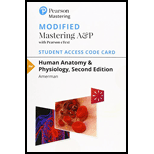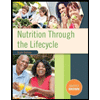
Modified Masteringa&p With Pearson Etext -- Standalone Access Card -- For Human Anatomy And Physiology
2nd Edition
ISBN: 9780134788074
Author: AMERMAN, Erin C.
Publisher: Pearson Education Canada
expand_more
expand_more
format_list_bulleted
Textbook Question
thumb_up100%
Chapter 1.3, Problem 2QC
Fill in the blanks:
The nose is to the mouth.
The ankle is to the knee.
The ring finger is to the index finger.
The skin is to the bone.
The trachea is to the spine.
The shoulder is to the wrist.
Expert Solution & Answer
Learn your wayIncludes step-by-step video

schedule04:47
Students have asked these similar questions
C
MasteringHealth MasteringNu ×
session.healthandnutrition-mastering.pearson.com/myct/itemView?assignment ProblemID=17396416&attemptNo=1&offset=prev
10. Your instructor will give you 2 amino acids during the activity session (video 2-7.
A. First color all the polar and non-polar covalent bonds in the R groups of your 2 amino acids
using the same colors as in #7. Do not color the bonds in the backbone of each amino acid.
B. Next, color where all the hydrogen bonds, hydrophobic interactions and ionic bonds could
occur in the R group of each amino acid. Use the same colors as in #7. Do not color the bonds
in the backbone of each amino acid.
C. Position the two amino acids on the page below in an orientation where the two R groups
could bond together. Once you are satisfied, staple or tape the amino acids in place and label
the bond that you formed between the two R groups.
- Polar covalent Bond - Red
- Non polar Covalent boND- yellow
- Ionic BonD - PINK
Hydrogen Bonn - Purple
Hydrophobic interaction-green
O=C-N
H
I.
H
HO
H
=O
CH2
C-C-N
HICK
H
HO
H
CH2
OH
H₂N
C = O
Find the dental formula and enter it in the following format:
I3/3 C1/1 P4/4 M2/3 = 42 (this is not the correct number, just the correct format)
Please be aware: the upper jaw is intact (all teeth are present). The bottom jaw/mandible is not intact. The front teeth should include 6 total rectangular teeth (3 on each side) and 2 total large triangular teeth (1 on each side).
Chapter 1 Solutions
Modified Masteringa&p With Pearson Etext -- Standalone Access Card -- For Human Anatomy And Physiology
Ch. 1.1 - What are some examples of learning modalities?Ch. 1.1 - 2. How should you approach reading a textbook,...Ch. 1.1 - What are some study strategies to improve your...Ch. 1.1 - Prob. 4QCCh. 1.1 - 5. What are some strategies for taking good notes...Ch. 1.1 - 6. How can you use the features found in each...Ch. 1.1 - 7. How should you approach the study of figures...Ch. 1.2 - What are the properties common to all living...Ch. 1.2 - Prob. 2QCCh. 1.2 - 3. What are the 11 organ systems in the body?
Ch. 1.2 - 4. How do gross anatomy and microscopic anatomy...Ch. 1.2 - How are physiological specializations classified?Ch. 1.3 - What is anatomical position?Ch. 1.3 - Fill in the blanks: The nose is to the mouth....Ch. 1.3 - Fill in the blanks: a. The wrist is also known as...Ch. 1.3 - How do the three main planes of section differ?Ch. 1.4 - What are the two subcavities of the posterior body...Ch. 1.4 - 2. List the subdivisions of the thoracic and...Ch. 1.4 - 3. What are serous membranes, and what are their...Ch. 1.4 - Explain how serous membranes form certain anterior...Ch. 1.5 - 1. What is homeostasis, and why is it important?
Ch. 1.5 - 2. What is a homeostatic imbalance?
Ch. 1.5 - How do negative feedback loops maintain...Ch. 1.5 - Prob. 4QCCh. 1.5 - Prob. 5QCCh. 1.5 - What is a gradient? What are some examples of...Ch. 1.5 - 7. Why is cell-cell communication important?
Ch. 1.5 - 8. What are the two major methods by which cells...Ch. 1 - Fill in the blanks: The study of the form of the...Ch. 1 - Mark the following statements as true or false. If...Ch. 1 - Prob. 3CYRCh. 1 - Prob. 4CYRCh. 1 - 5. Which of the following correctly describes the...Ch. 1 - Mark the following statements as true or false. If...Ch. 1 - Match the following terms with the correct...Ch. 1 - 8. The upper and lower limbs are known broadly as...Ch. 1 - The arm is known as the ___________ region; the...Ch. 1 - A parasagittal section divides the body or body...Ch. 1 - 11. Fill in the blanks: The two divisions of the...Ch. 1 - 12. Fill in the blanks: The two main divisions of...Ch. 1 - 13. In which of the following cavities do serous...Ch. 1 - 14. Serous fluid functions in:
a. Providing...Ch. 1 - 15. Which organs would you expect to find in the...Ch. 1 - 16. Mark the following statements as true or...Ch. 1 - Prob. 17CYRCh. 1 - Examine the structure of the skull, and predict...Ch. 1 - Prob. 2CYUCh. 1 - Prob. 1AYKCh. 1 - 2. During a procedure on Ms. Norman’s pancreas, a...Ch. 1 - Later that same day, the surgeon performs a...Ch. 1 - The baroreceptor reflex causes blood pressure to...
Additional Science Textbook Solutions
Find more solutions based on key concepts
Police Captain Jeffers has suffered a myocardial infarction. a. Explain to his (nonmedically oriented) family w...
Human Physiology: An Integrated Approach (8th Edition)
The bioremediation process shown in the photograph is used to remove benzene and other hydrocarbons from soil c...
Microbiology: An Introduction
APPLY 1.2 Express the following quantities in scientific notation
using fundamental SI units of mass and lengt...
Chemistry (7th Edition)
1.3 Obtain a bottle of multivitamins and read the list of ingredients. What are four chemicals from the list?
Chemistry: An Introduction to General, Organic, and Biological Chemistry (13th Edition)
5.4 Genes E and H are syntenic in an experimental organism with the genotype . Assume
that during each meiosis,...
Genetic Analysis: An Integrated Approach (3rd Edition)
All of the following processes are involved in the carbon cycle except: a. photosynthesis b. cell respiration c...
Human Biology: Concepts and Current Issues (8th Edition)
Knowledge Booster
Learn more about
Need a deep-dive on the concept behind this application? Look no further. Learn more about this topic, biology and related others by exploring similar questions and additional content below.Similar questions
- 12. Calculate the area of a circle which has a radius of 1200 μm. Give your answer in mm² in scientific notation with the correct number of significant figures.arrow_forwardDescribe the image quality of the B.megaterium at 1000X before adding oil? What does adding oil do to the quality of the image?arrow_forwardWhich of the follwowing cells from this lab do you expect to have a nucleus and why or why not? Ceratium, Bacillus megaterium and Cheek epithelial cells?arrow_forward
- 14. If you determine there to be debris on your ocular lens, explain what is the best way to clean it off without damaging the lens?arrow_forward11. Write a simple formula for converting mm to μm when the number of mm's is known. Use the variable X to represent the number of mm's in your formula.arrow_forward13. When a smear containing cells is dried, the cells shrink due to the loss of water. What technique could you use to visualize and measure living cells without heat-fixing them? Hint: you did this technique in part I.arrow_forward
- 10. Write a simple formula for converting μm to mm when the number of μm's are known. Use the variable X to represent the number of um's in your formula.arrow_forward8. How many μm² is in one cm²; express the result in scientific notation. Show your calculations. 1 cm = 10 mm; 1 mm = 1000 μmarrow_forwardFind the dental formula and enter it in the following format: I3/3 C1/1 P4/4 M2/3 = 42 (this is not the correct number, just the correct format) Please be aware: the upper jaw is intact (all teeth are present). The bottom jaw/mandible is not intact. The front teeth should include 6 total rectangular teeth (3 on each side) and 2 total large triangular teeth (1 on each side).arrow_forward
- Answer iarrow_forwardAnswerarrow_forwardcalculate the questions showing the solution including variables,unit and equations all the questiosn below using the data a) B1, b) B2, c) hybrid rate constant (1) d) hybrid rate constant (2) e) t1/2,dist f) t1/2,elim g) k10 h) k12 i) k21 j) initial concentration (C0) k) central compartment volume (V1) l) steady-state volume (Vss) m) clearance (CL) AUC (0→10 min) using trapezoidal rule n) AUC (20→30 min) using trapezoidal rule o) AUCtail (AUC360→∞) p) total AUC (using short cut method) q) volume from AUC (VAUC)arrow_forward
arrow_back_ios
SEE MORE QUESTIONS
arrow_forward_ios
Recommended textbooks for you
 Fundamentals of Sectional Anatomy: An Imaging App...BiologyISBN:9781133960867Author:Denise L. LazoPublisher:Cengage LearningLifetime Physical Fitness & WellnessHealth & NutritionISBN:9781337677509Author:HOEGERPublisher:Cengage
Fundamentals of Sectional Anatomy: An Imaging App...BiologyISBN:9781133960867Author:Denise L. LazoPublisher:Cengage LearningLifetime Physical Fitness & WellnessHealth & NutritionISBN:9781337677509Author:HOEGERPublisher:Cengage Medical Terminology for Health Professions, Spira...Health & NutritionISBN:9781305634350Author:Ann Ehrlich, Carol L. Schroeder, Laura Ehrlich, Katrina A. SchroederPublisher:Cengage Learning
Medical Terminology for Health Professions, Spira...Health & NutritionISBN:9781305634350Author:Ann Ehrlich, Carol L. Schroeder, Laura Ehrlich, Katrina A. SchroederPublisher:Cengage Learning Nutrition Through the Life Cycle (MindTap Course ...Health & NutritionISBN:9781305628007Author:Judith E. BrownPublisher:Cengage Learning
Nutrition Through the Life Cycle (MindTap Course ...Health & NutritionISBN:9781305628007Author:Judith E. BrownPublisher:Cengage Learning

Fundamentals of Sectional Anatomy: An Imaging App...
Biology
ISBN:9781133960867
Author:Denise L. Lazo
Publisher:Cengage Learning


Lifetime Physical Fitness & Wellness
Health & Nutrition
ISBN:9781337677509
Author:HOEGER
Publisher:Cengage

Medical Terminology for Health Professions, Spira...
Health & Nutrition
ISBN:9781305634350
Author:Ann Ehrlich, Carol L. Schroeder, Laura Ehrlich, Katrina A. Schroeder
Publisher:Cengage Learning

Nutrition Through the Life Cycle (MindTap Course ...
Health & Nutrition
ISBN:9781305628007
Author:Judith E. Brown
Publisher:Cengage Learning

The Skeletal System; Author: Professor Dave Explains;https://www.youtube.com/watch?v=f-FF7Qigd3U;License: Standard YouTube License, CC-BY